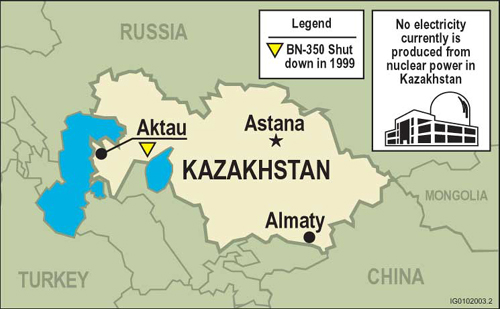8.0 Kazakhstan
In April 1999, Kazakhstan agreed to shut down its Soviet-designed BN-350, sodium-cooled, fast-breeder reactor located in the city of Aktau on the eastern shore of the Caspian Sea. The reactor began operating in the formerly closed city in 1972. It operated on an open uranium fuel cycle optimized to produce plutonium for the Soviet Union's nuclear weapons complex. Steam produced by the plant was used for electricity generation, heating and seawater desalination.
Historically, Russian organizations carried the primary responsibility for supporting safe operations and maintenance of Soviet-designed reactors such as the BN-350 in Kazakhstan. With the breakup of the Soviet Union, the plant lost key experienced staff and ready access to Russian scientific institutes. As a result, Kazakhstan needs technical and financial assistance to maintain the shut-down plant in an environmentally, radiologically, and industrially safe condition until it can be dismantled.
Kazakhstan also operates four research and test reactors originally used for defense purposes elsewhere in the country.

DOE is assisting in the irreversible shut down of the BN-350
fast-breeder reactor.
8.1 Reactor Shutdown and Safe Storage
In early 1999, the Department of Energy began providing technical assistance to address immediate safety issues at the BN-350 fast-breeder reactor. In December 1999, the U.S. Secretary of Energy and the Kazakhstan Minister of Energy, Industry and Trade, signed a joint implementing arrangement in which the United States agreed to assist in the irreversible shutdown of the reactor. U.S. assistance is focused on decommissioning planning and sodium management activities. Sodium coolant management activities include decontaminating, draining, and processing the coolant to an environmentally benign substance, and then treating residual sodium in the reactor vessel and piping. The sodium coolant is highly radioactive (with cesium-137) due to past fuel failures. Upon completion of these activities, the United States and its Kazakhstan partners will have rendered restart of the reactor impractical, thus eliminating a source of weapons material production in a strategically vulnerable region.
In parallel with the sodium management activities, the United States is collaborating, through the International Atomic Energy Agency, with Kazakhstan, the United Kingdom, and the European Union TACIS Program to develop a decommissioning plan. The decommissioning plan will be used by Kazakhstan to solicit international technical and financial assistance to place the facility in a safe storage condition until it can be dismantled.
8.2 Nuclear Technology Safety Center
Kazakhstan established the Nuclear Technology Safety Center in 1998 to perform independent safety analyses of the country's nuclear facilities. The Safety Center is located in Almaty and is collocated with the Kazakhstan Atomic Energy Committee, the country's nuclear regulator. Creation of the Safety Center is a milestone in Kazakhstan's effort to improve its nuclear safety infrastructure, which required it to fill the void left by Russian scientific institutes after the breakup of the Soviet Union. This void has been exacerbated by departure of nuclear specialists to Russia. The United States provided computer hardware and software resources, and training to assist in the establishment of the Safety Center.
Specialists from the Safety Center collaborated with U.S. specialists to improve the safety of the BN-350 reactor while it was in operation. This collaboration included exchanges of technical information and participation in workshops on operations and maintenance. U.S. specialists are working with Kazakh specialists to develop in-country expertise in conducting nuclear safety analyses. U.S.-developed safety analysis codes have been installed on the Safety Center's computer network. Configuration control procedures and quality assurance plans have been developed for the safety analysis reviews performed at the Safety Center. In support of the BN-350 Spent Fuel Disposition Program, Safety Center personnel participated in development of safety analysis reports for both the storage and transportation projects.
Kazakh personnel have participated in short-term training assignments at Argonne National Laboratory West in Idaho Falls, Idaho, where they were involved in EBR-II reactor closure projects.
The Safety Center is playing a vital role in the BN-350 Reactor Shutdown Program by managing development of the decommissioning plan and providing technical expertise for design of the cesium traps that will be used to decontaminate the sodium coolant. In addition, the Safety Center is providing financial management services for shutdown activities.